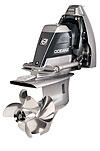Coating Dramatically Improves Corrosion Resistance of Stern Drives and Manifolds for Pleasure Craft
This coating technology allowed Volvo Penta engineers to substitute aluminum as the substrate of choice for its manifold redesign for pleasure craft.

Volvo Penta, a leading worldwide supplier of engines and complete power systems for marine and industrial use, recently redesigned one of their leading engine exhaust systems and stern drives used on 20- to 35-foot pleasure craft. The goal of the redesign was to make the equipment more durable in highly corrosive saltwater environments and to reduce the weight of the assemblies. Reducing weight means that boats can accelerate more rapidly, plane out faster and travel at higher top-end speeds using less fuel.
Designed for use with select gasoline and diesel engines, the new Volvo Penta Ocean X stern drive and engine exhaust system are higher quality, more environmentally friendly components that provide pleasure craft owners with enhanced performance, lower operating expenses and fewer warranty issues.
Chromate has long been the industry’s standard method of retarding corrosion, but contains an extremely hazardous, EPA-regulated carcinogen that can contribute to medical problems including various cancers and skin irritations. The chromate-coating process also generates hazardous water waste effluent that requires a complex on-site water treatment facility at Volvo Penta.
During the redesign process, Volvo Penta had two goals: to better protect the stern drive assembly from corrosion, and to eliminate the dangerous, expensive and environmentally hazardous chromate coating process.

The manifold exhaust stream gets as hot as 850 ºC. The exhaust gases must pass through aluminum and rubber components before entering the body of water. To ensure that these components do not melt from exposure to these super-heated gases, seawater passes over the manifold, cooling the exhaust. As this seawater is highly corrosive, few substrate materials will withstand ongoing exposure.
Volvo Penta’s existing exhaust system was made of heavy cast iron that was painted for optimum corrosion resistance. To reduce the weight of the newly designed, larger engine exhaust system, Volvo Penta engineers wanted to use a lighter substrate material such as aluminum, but were challenged to find a material that could withstand the corrosive seawater and temperature extremes.
Henkel’s Alodine EC2 product is an environmentally safe, less complicated coating process that produces no effluent that would require water treatment processing. This coating technology allowed Volvo Penta engineers to substitute aluminum as the substrate of choice for the manifold redesign. Coated with Alodine EC2, this lighter substrate performed at levels exceeding all expectations. As aluminum is much less dense than cast iron, Volvo Penta greatly reduced the weight of the exhaust manifold, improving both fuel economy and overall performance.
As electroceramic coating technology is compatible with most typical paint finishes such as e-coat, powder and liquid paint systems, this coating process easily accepted the paints used to make the Ocean X stern drive and engine exhaust system more aesthetically pleasing.
Aluminum components coated with EC2 have now been used at Volvo Penta for approximately two years. With the Alodine EC2 coating, corrosion resistance is dramatically improved when compared to chromate coated parts. During testing, electroceramic coated parts were scratched and then subjected to salt water immersion and tidal testing. With EC2, scratched surfaces easily resisted corrosion damage creep, the deepening and widening of the damaged area.
In October of 2009, Volvo Penta was awarded the IBEX Innovation Award for the new Ocean X stern drive design.

Volvo Penta, a leading worldwide supplier of engines and complete power systems for marine and industrial use, recently redesigned one of their leading engine exhaust systems and stern drives used on 20- to 35-foot pleasure craft. The goal of the redesign was to make the equipment more durable in highly corrosive saltwater environments and to reduce the weight of the assemblies. Reducing weight means that boats can accelerate more rapidly, plane out faster and travel at higher top-end speeds using less fuel.
Designed for use with select gasoline and diesel engines, the new Volvo Penta Ocean X stern drive and engine exhaust system are higher quality, more environmentally friendly components that provide pleasure craft owners with enhanced performance, lower operating expenses and fewer warranty issues.
Stern Drive Redesign
Continuously exposed to seawater, Volvo Penta’s stern drive/prop assembly housings are made completely of aluminum, a material that can be very susceptible to corrosion. To protect from corrosion, the company had been applying a chromate coating to the aluminum for more than 30 years.Chromate has long been the industry’s standard method of retarding corrosion, but contains an extremely hazardous, EPA-regulated carcinogen that can contribute to medical problems including various cancers and skin irritations. The chromate-coating process also generates hazardous water waste effluent that requires a complex on-site water treatment facility at Volvo Penta.
During the redesign process, Volvo Penta had two goals: to better protect the stern drive assembly from corrosion, and to eliminate the dangerous, expensive and environmentally hazardous chromate coating process.

Manifold Redesign
As of January 2010 the EPA introduced new emissions regulations requiring catalytic converters to improve exhaust emissions. Anticipating this deadline, Volvo Penta began to redesign its exhaust manifold in January of 2008 to meet the pending federal requirements. But the addition of a catalytic converter would not only add to the overall size of the engine exhaust system, it would also greatly increase its weight.The manifold exhaust stream gets as hot as 850 ºC. The exhaust gases must pass through aluminum and rubber components before entering the body of water. To ensure that these components do not melt from exposure to these super-heated gases, seawater passes over the manifold, cooling the exhaust. As this seawater is highly corrosive, few substrate materials will withstand ongoing exposure.
Volvo Penta’s existing exhaust system was made of heavy cast iron that was painted for optimum corrosion resistance. To reduce the weight of the newly designed, larger engine exhaust system, Volvo Penta engineers wanted to use a lighter substrate material such as aluminum, but were challenged to find a material that could withstand the corrosive seawater and temperature extremes.
Henkel's Solution
Representatives from Volvo Penta attended an industry conference where a Henkel scientist was presenting technical information on the company’s Alodine® EC2™ electroceramic coating technology. Designed to work on most light metal surfaces, Alodine EC2 forms a protective layer of titanium dioxide ceramic that resists corrosion, increases wear resistance and reduces surface friction on the finished coated surface.Henkel’s Alodine EC2 product is an environmentally safe, less complicated coating process that produces no effluent that would require water treatment processing. This coating technology allowed Volvo Penta engineers to substitute aluminum as the substrate of choice for the manifold redesign. Coated with Alodine EC2, this lighter substrate performed at levels exceeding all expectations. As aluminum is much less dense than cast iron, Volvo Penta greatly reduced the weight of the exhaust manifold, improving both fuel economy and overall performance.
As electroceramic coating technology is compatible with most typical paint finishes such as e-coat, powder and liquid paint systems, this coating process easily accepted the paints used to make the Ocean X stern drive and engine exhaust system more aesthetically pleasing.
Aluminum components coated with EC2 have now been used at Volvo Penta for approximately two years. With the Alodine EC2 coating, corrosion resistance is dramatically improved when compared to chromate coated parts. During testing, electroceramic coated parts were scratched and then subjected to salt water immersion and tidal testing. With EC2, scratched surfaces easily resisted corrosion damage creep, the deepening and widening of the damaged area.
In October of 2009, Volvo Penta was awarded the IBEX Innovation Award for the new Ocean X stern drive design.
Looking for a reprint of this article?
From high-res PDFs to custom plaques, order your copy today!








